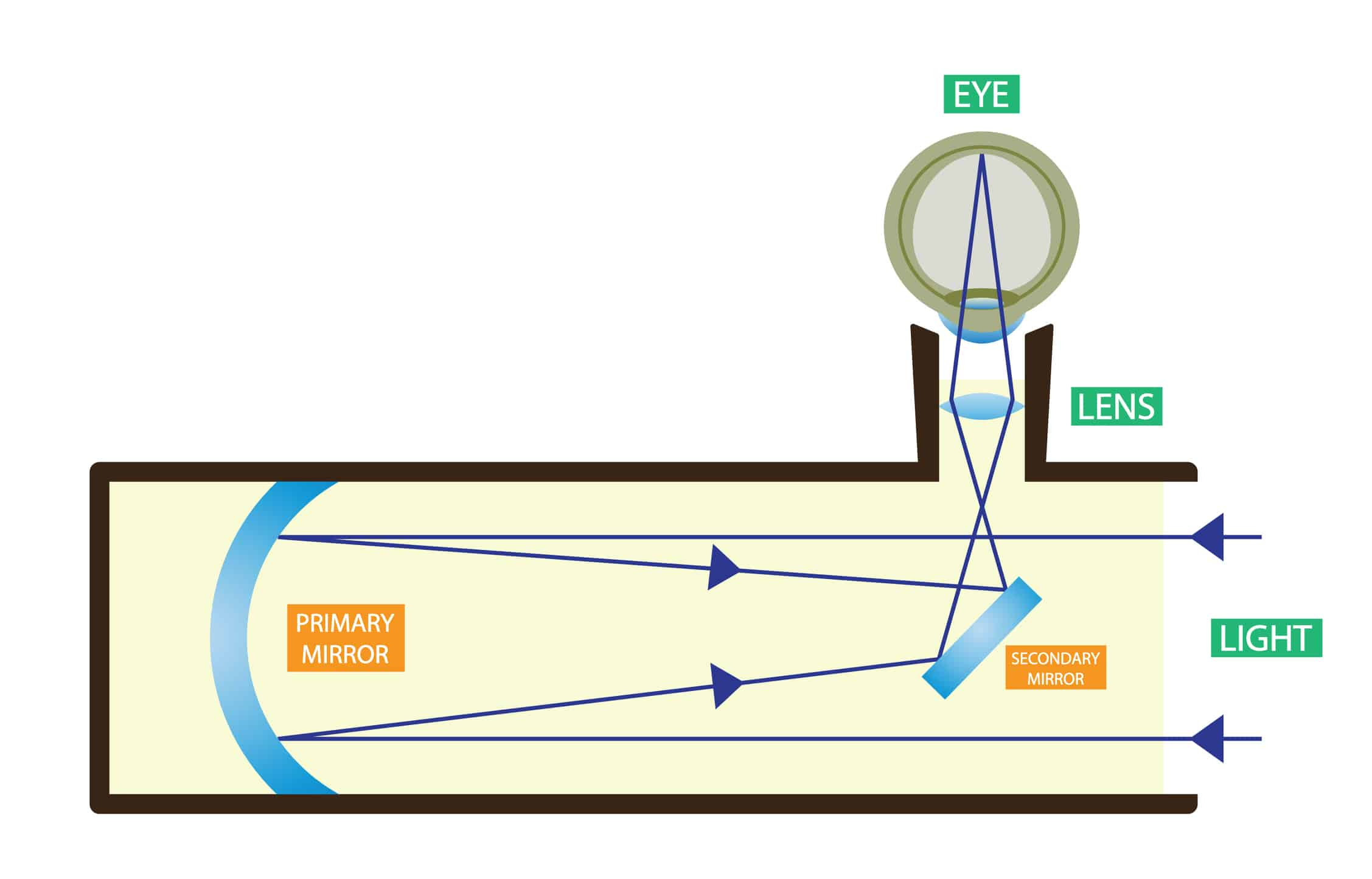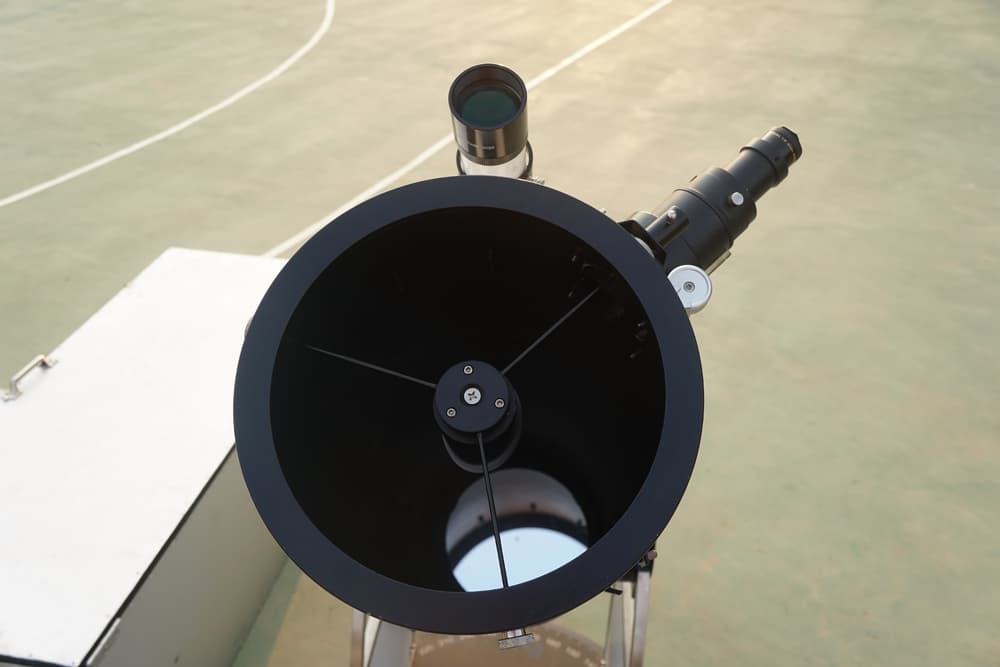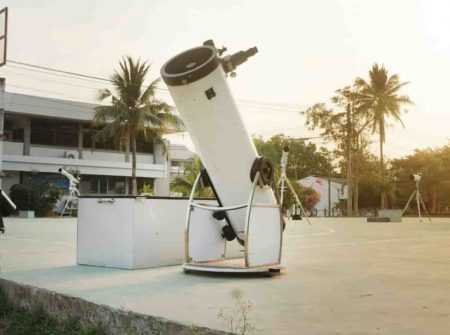What is a Dobsonian Telescope? A backyard astronomer's best friend
Last Updated: 25 September 2020
Dobsonian telescopes are a type of reflecting telescope that is very popular in the visual astronomy community. They work by reflecting the light travelling inside their optical tube assembly (OTA) from a curved primary mirror to a flat secondary mirror which then directs the light to the focuser. What makes those telescopes “Dobsonian” is the fact that they are mounted on a simple altazimuth mount.
This telescope design was created by John Dobson in 1965, who wanted to make amateur astronomy accessible to a larger number of people. He nicknamed his project “the sidewalk telescope” because he used to take his Dobsonian telescope through the streets of San Francisco and let bypassers look at the night sky through the eyepiece.
Table of Contents
How do they work?
When you point a Dobsonian telescope at a celestial target, it collects light rays from that object through the aperture (the opening). This light travels inside the telescope’s optical tube assembly and hits the parabolic mirror placed at the end of the tube. The light then bounces off the primary mirror and is directed towards the flat secondary mirror. It bounces off the secondary mirror again and is sent to the focuser where you place your eyepiece.
For this to work perfectly, your telescope must be properly collimated. This means aligning the primary mirror so that the light bouncing off it is perfectly directed toward the secondary mirror without any loss of light rays.
And that’s it! It’s a very simple telescope to use. They are nicknamed “Light Buckets” because their wide opening makes their light-gathering capability one of the best on the market. As long as you are fine with having to manually find and track your telescopic targets yourself, a Dobsonian telescope is without a doubt the best choice for getting started with visual astronomy. Regarding accessories, you should experiment with eyepieces and Barlow lenses to see what works best based on what you observe.

What type of mount do they use?
The Dobsonians are mounted on an altazimuth platform. To point your OTA towards your chosen target in the sky, you will first have to manually orient the telescope to the right or left by gently pushing the azimuth turntable. Then you will need to adjust the altitude axis by turning the control knob on the side of the rocker box, which allows you to move the optical tube up or down. Once you have your desired target in the centre of the eyepiece, you can tighten the control knob to hold the tube in place.
Dobsonian mounts are indeed very simple in design and easy to manufacture, which is part of the reason why they are so affordable. They are quite robust too which is particularly important when using large aperture telescopes.
When placing the Dobsonian mount on your observing spot, make sure that the base is properly levelled on the ground. Some astronomers also place the mount on a vibration pad which significantly reduces vibrations around the telescope and makes for a better viewing experience.
The advantages of using a Dobsonian telescope
They have large apertures
Dobsonian telescopes are renowned for offering the widest aperture at the best price. The aperture is the size of the opening of the telescope where the light enters the OTA (optical tube assembly). The larger the aperture = the telescope collects more light = the observed image is brighter and sharper. They are therefore popular for visual astronomy: the planets, the moon and some deep-sky objects are great celestial targets for this type of reflecting telescope. Dobsonians are particularly suitable for large openings (6 inches up to 36 inches) because they use mirrors instead of glass, which means they are cheaper to manufacture than refractors (doublet & triplet) and Schmidt-Cassegrains.
They are great for planetary observation
Dobsonians are among the best planetary telescopes available to purchase with a low budget. Their large aperture allows them to collect lots of light reflecting off the planets, meaning that you may enjoy a much brighter and clearer image inside the eyepiece. Jupiter and Saturn are among the most popular targets, as Dobsonians can easily resolve the great red spot and Saturn’s ring. Their large aperture means that Dobsonians are more sensitive to atmospheric turbulence, so a steady “seeing” is very important when observing the planets. If the weather is on your side, be prepared to be wowed at the view of the giant planets and their moons.
They are easy to use
Dobsonians are among the easiest and quickest telescopes to set up. You just need to place them on the observation spot, check that they are well collimated, select your eyepiece, locate your target with the help of a stargazing mobile app, point the telescope at it, and you’re ready to go! They don’t require any cables to connect to a computer, any power source for the mount, any polar alignment, or any complex software setup. For these reasons, they are particularly popular at star parties and are a prime choice as a first telescope for beginners.
The eyepiece is also ideally placed, at the top of the OTA which means you don’t have to bend down too much to observe the starry sky.
Lower cost compared to other types of telescope
As we mentioned before, reflectors are less expensive than a refractor or a Catadioptric telescope. They are perfect for beginners because they offer the most power for the least amount of money. This is due to the fact that they are not costly to manufacture… The mount is mostly made of wood, and the OTA uses mirrors rather than high-grade glass lenses with a special coating. It is hard to not be tempted by a full astronomy kit that includes: a powerful telescope, a solid mount, and a set of high-quality eyepieces, and sometimes a moon filter for about 350 dollars.
They do not suffer from image distortion
To enjoy a sharp view of your target in your eyepiece, you want all the light collected through the aperture to be focused at the same point and at the same time. Some telescopes that collect light through a lens, for example, suffer from what is known as chromatic aberration. This is when the different coloured light rays (red, blue, green) are not focused on exactly the same place, causing colour fringes in the image. For example, Jupiter may appear to have a subtle but distinct red and blue hue on its sides.
Because Dobsonian uses mirrors to reflect light, each wavelength of the spectrum hits exactly the same point at the same time.
The cons of using a Dobsonian telescope
Big Size
Although an 8 or 10 inch Dobsonian telescope can be carried by one person, it is not really a “grab and go” type telescope. If you want to go to a dark sky area, you will need sufficient space in your car. Also, if you’ve had a long day, you may not be motivated to lift 45 pounds worth of equipment from your storage space to your backyard. Consider this fact before you buy a Dobsonian, as you probably don’t want to invest in a telescope that will only be used a few times a year.
Harder to store
Before buying a Dobsonian scope, you need to determine if you have enough room to store it in your home or backyard shed. Dobsonian telescopes are quite large and take up a bit of space. Due to their optical design, their aperture is actually quite wide and open, which makes it easy for dust and moisture to reach the mirrors. It is therefore important not only to find a space large enough to store them but also to make sure that the place is adequate for a high-quality astronomical telescope.
They are not suitable for astrophotography
You won’t be able to see every single object from the Messier Catalog. Unfortunately, because classic Dobsonians use an Alt-Azimuth mount, they are not suitable for taking images of deep-sky objects. They are lacking one of the most important factors for astrophotography: a tracking mount that allows you to take long exposure pictures with your DSLR. A motorised equatorial is paramount for astrophotography as it counters the Earth’s rotation. Without it, your images would be full of star trails.
If you are interested in taking photos of deep-sky objects, you should look into getting a Newtonian or a Refracting telescope and a motorised equatorial mount instead.
What can you observe with a Dobsonian Telescope?
You can easily observe the most interesting planets such as Venus, Mars, Jupiter and Saturn. Dobsonians are sometimes called “planet busters” as they have the perfect telescope features for observing them: large aperture and long focal length. Adding a Barlow lens can really increase the magnification power of the telescope and improve your viewing experience.
Venus: You will be able to observe the different phases the planet is going through.
Mars: You will see the distinct red colours as well as the polar ice caps.
Jupiter: You will appreciate the different colours in Jupiter’s belts, the big red spot as well as the Galilean moons (Io, Europa, Ganymede and Callisto).
Saturn: You should easily resolve the shape of the planet, some colour differentiation, Saturn’s ring including the Cassini division. On a clear night with a stable atmosphere, you may even be able to observe Saturn’s main moons: Titan, Rhea, Dione, Tethys, Enceladus and Mimas.
I have never tried to observe the most distant planets (Neptune and Uranus) because they are too far away and would probably look like a bluish ball of light.
Dobsonians can give you access to many of the brightest deep-sky objects (galaxies, nebulae and star clusters), such as the Pleiades, Orion and Andromeda. These deep space targets can only be visually observed since it is very difficult to do any Astro imaging with this type of telescope.
How to care for your Dobsonian telescope
Telescopes are an important investment. There is no other way to describe it. Whether you have a big or small budget… when you spend a few hundred dollars on a single piece of equipment, you want it to last. Although Dobsonians are durable and require little maintenance, we have a few recommendations that will help you protect them and make them last longer.
- Some classic Dobsonians bases are made of particle wood glued together (like some Ikea furniture) which makes them particularly vulnerable to moisture and causes them to bend and warp slowly over time. Avoid placing your Dobsonian mount on wet or snowy grass. Some users have built an elevated wooden platform for the scope to sit on during their stargazing sessions.
- Store your OTA inside a large travel bag. This ensures that your tube is protected from moisture in the storage area, from any insects deciding to live in your telescope and from any dust reaching your primary mirror.
- Due to the temperature difference between the outside and inside, some dew may form inside your telescope once you bring it home. Do not put the dust cap on for about half an hour to allow the dew to dissipate. Point the telescope down while you let it defog to prevent dust from entering.
- Dobsonians require regular collimation because the primary mirror might move a little when you move the telescope in and out of the house. Collimating your telescope is the act of realigning the primary mirror by adjusting the three small rotating knobs at the back of the telescope. This ensures that the collected light is fully directed toward the secondary mirror so that you don’t lose any “data”.

How much does a Dobsonian telescope costs?
50 to 250 dollars: Tabletop Dobsonians are a smaller version of the classical Dobsonian. Make no mistake, they may look like children’s telescopes, but they are much more powerful. They are perfect for the space lover who simply wants to enjoy the night sky every now and again without getting into astronomy too seriously.
250 to 500 dollars: This is the ideal price range for those who want to become a little more serious about visual astronomy. Dobsonians with a 6 or 8-inch aperture are the best introductory telescopes as they offer the best value for the money for beginners.
500 to 1000 Dollars: At this price point, Dobsonian telescopes get very large, 10 or 12 inch in aperture size. This is usually the upgrade that experienced astronomers go for, should they decide to stay in the visual astronomy field rather than astrophotography.
1000 to 2500 dollars: If you are wanting la creme de la creme of Dobsonians. At this level, your telescope will come with a super large aperture (14” to 16”). They will be equipped with fantastic features such as the collapsible FlexTube design and SynScan computerised Go-To technology.
Related: Our beginner’s guide on how to buy a telescope.
Where can you purchase a Dobsonian?
As they are relatively affordable, I recommend that you buy a brand new Dobsonian rather than a used one on eBay or gumtree. This way, you can be sure that the equipment is delivered in impeccable condition and under warranty.
If you are buying a telescope for the first time, I suggest you visit your nearest astronomy shop. There, you will be able to talk to an experienced astronomer who can explain to you how Dobsonian works, what it can and cannot do. They are very helpful and happy to share their passion for telescopes and astronomy in general.
If you don’t have access to an astronomy shop, there are a number of online shops where you can browse and choose a Dobsonian :
Online UK Stores
- https://www.harrisontelescopes.co.uk/
- https://uk.telescope.com/
- https://www.telescopehouse.com/
- https://www.tringastro.co.uk/
Online US Stores
- https://www.highpointscientific.com/
- https://www.telescope.com/
- https://optcorp.com/
- https://telescopes.net/
Among the brands you want to check out, Apertura (in particular the Apertura AD8 model) has a reputation for building superb Dobsonian telescopes at a great price. Other reputable brands include Sky-Watcher, Orion, Meade and Zhumell.
Note: Some telescope manufacturers are known to increase their prices when demand is high. Take the time to research the telescope you are interested in. There are tons of online resources, such as forums where you can get advice.
Building Your Own Dobsonian
The design of this classic telescope is so simple that many people have managed to build their own homemade Dobsonian using basic materials such as plywood, wood and metal fasteners. The most important part of the project, as well as the most expensive, are the primary parabolic mirror, the secondary flat mirror and the focuser. It is essential to calculate exactly how far the secondary mirror must be placed from the primary mirror in order to achieve focus. There are many videos describing the process from beginning to end:
If you ever built your own Dobsonian, let us know in the comment, we would love to feature your images!
Upgrading your telescope
Like any other astronomer with a passion for this fascinating hobby, there will come a time when you will master your Dobsonian telescope perfectly. You will have used it to its full potential and will be looking for ways to get more power out of it. It will be time to upgrade it! The usual next step for a visual astronomer would be to start experimenting with astrophotography. Fortunately for you, there are many excellent Newtonian telescopes that are perfect for imaging objects in deep space. So you won’t be lost, because the optical design is the same as your old Dobsonian.
If you are perfectly happy with observing planets, the moon and some DSOs, then your telescope upgrade would simply be a Dobsonian with a larger aperture or one with more advanced features like a collapsible optical tube or even a GoTo functionality. Since Dobsonians are a popular type of telescope, you should have no problem selling your faithful telescope on the different online marketplaces.
Do you own a Dobsonian telescope? We’d love to hear your experience with it in the comment section!

Telescopes are complex optical systems and it can take a little time to learn how to use them optimally. I hope to make this learning process a little easier by providing some of my tips and my experience on how to get the most out of your telescope.
Recommended Reading
Buying a high-quality telescope can be a significant investment. To help you plan your budget, we have created this guide about telescope prices in 2021.
If you always wanted to observe the planets from your backyard, this simple guide will help you get started.
Applications for smartphones have revolutionized the world of amateur astronomy. It is now easier than ever to find your way around the night sky.

